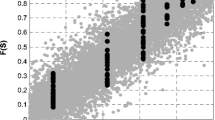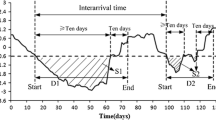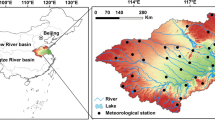Abstract
The Wei River Basin, a typical arid and semi-arid region, is frequently attacked by droughts, which heavily limits its sustainable development of society and economy. Therefore, the main motivation of this study is to investigate the drought evolution characteristics and risk evaluation in the basin, which is crucial for drought warning, water resources management as well as agricultural development. The modified Mann-Kendall test trend method was used to capture the trend of the severity and duration of historical drought events, and the persistence of droughts was analyzed based on the Rescaled Range (R/S) analysis. Additionally, the Morlet wavelet analysis was utilized to calculate the period of dry and wet condition, and copulas were applied to calculate the joint return period of two typical scenarios. The main results are as follows: (1) the whole basin has an obviously dry trend, especially in autumn and winter; furthermore, the months with a wet trend are primarily concentrated in July and August; (2) the persistence of droughts is strong, indicating that droughts in the near future may be persistent; (3) the average “or” and “and” joint return periods under scenario (1) where drought duration is 6 months and drought severity is 4 are approximately 15.6 and 28.9 years, respectively, while those under scenario (2) where drought duration is 8 months and drought severity is 6 are approximately 34.9 and 53.1 years, respectively. In general, the drought risk of the northwestern basin is larger than that of the southeastern basin.





Similar content being viewed by others

References
Angelidis P, Maris F, Kotsovinos N et al (2012) Computation of Drought Index SPI with alternative distribution functions. Water Resour Manag 26(9):2453–2473
Beniston M, Stephenson DB (2004) Extreme climatic events and their evolution under changing climatic conditions. Glob Planet Chang 44:1–9
Camp CD, Tung KK (2007) Surface warming by the solar cycle as revealed by the composite mean difference projection. Geophys Res Lett 34, L14703
Christensen OB, Christensen JH (2004) Intensification of extreme European summer precipitation in a warmer climate. Glob Planet Chang 44:107–117
Cong YZ, Han GZ, Wang HY (1995) Discussion about characteristics of geomagnetic field element’s spatio-temporal changes and their relations to environmental changes since 5 000a B.P. J Oceanogr Huanghai Bohai Seas 13(3):20–25 (In Chinese)
Genest C, Rivest LP (1993) Statistical inference procedures for bivariate Archimedean Copulas. Am Stat Assoc 88(423):1034–1043
Hamed KH, Rao AR (1998) A modified Mann–Kendall trend test for autocorrelated data. J Hydrol 204:182–196
Heim RR (2002) A review of twentieth-century drought indices used in the United States. Bull Am Meteorol Soc 8:1149–1165
Huang SZ, Liu DF, Huang Q, et al., 2014a. Contribution of climate variability and human activities to the variation in runoff in Wei River Basin, China. Hydrol Sci J. In press. doi:10.1080/02626667.2014.959955
Huang SZ, Chang JX, Huang Q et al (2014b) Spatio-temporal changes and frequency analysis of Drought in the Wei River Basin, China. Water Resour Manag 28(10):3095–3110
Huard D, Évin G, Favre AC (2006) Bayesian copula selection. Comput Stat Data Anal 51:809–822
Kendall MG (1955) Rank correlation methods. Griffin, London
Kunkel KE (2003) North American trends in extreme precipitation. Natural hazards 29:291–305
Lei YH, Duan AM (2010) Prolonged dry episodes and drought over China. Int J Climatol 31(12):1831–1840. doi:10.1002/joc.2197
Leng GY, Tang QH, Huang MY et al (2014) A comparative analysis of the impacts of climate change and irrigation on land surface and subsurface hydrology in the North China Plain. Reg Environ Chang. doi:10.1007/s10113-014-0640-x
Li JL, Yan JP, Sun H et al (2005) An analysis on climatic changes in East, Middle and West areas of Guanzhong Plain. J Arid Land Resour Environ 19(1):130–134 (In Chinese)
Lioyd-Hughes B (2010) A spatio-temporal structure-based approach to drought characterisation. Int J Climatol. doi:10.1002/joc.2280
Livada I, Assimakopoulos VD (2007) Spatial and temporal analysis of drought in Greece using the standardized precipitation index (SPI). Theor Appl Climatol 89:143–153
Logan KE, Brunsell NA, Jones AR et al (2010) Assessing spatiotemporal variability of drought in the U.S. central plains. J Arid Environ 74:247–255
Ma MW, Song SB (2012) Study on spatial distribution of Drought Indices in the Weihe River Basin. Arid Zone Res 29(4):681–691 (In Chinese)
Mann HB (1945) Nonparametric tests against trend. Econometrica 13:245–259
McKee TB, Doesken NJ, Kleist J (1993) The relationship of drought frequency and duration to time scales. Preprints Eighth Conference on Applied Climatology, American Meteorological Society, Anaheim, CA, pp. 179–184
Mishra AK, Singh VP (2010) A review of drought concepts. J Hydrol 391:202–216
Mitchell JM, Dzerdzeevskii B, Flohn H (1966) Climate change, WHO technical note 79. World Meteorological Organization, Geneva, p 79
Morid S, Smakhtin V, Moghaddasi M (2006) Comparison of seven meteorological indices for drought monitoring in Iran. Int J Climatol 26:971–985
Mudelsee M, Börngen M, Tetzlaff G et al (2003) No upward trends in the occurrence of extreme floods in the central Europe. Nature 425:166–169
Oliver R, Ballester JL (1996) Rescaled range analysis of the asymmetry of solar activity. Sol Phys 169(1):215–224
Qu WZ, Deng SG, Huang F et al (2004) Influence of magnetic index abnormal change in the solar magnetic field on climate at the middle latitudes of north hemisphere. Chin J Geophys 47(3):398–404 (In Chinese)
Raziei T, Bordi I, Pereira LS (2013) Regional Drought modes in Iran using the SPI: the effect of time scale and spatial resolution. Water Resour Manag 27:1661–1674
Roy SE, Balling RC (2004) Trends in extreme daily precipitation indices in India. Int J Climatol 24:457–466
Tsakiris G, Pangalou D, Vangelis H (2007) Regional Drought assessment based on the reconnaissance Drought Index (RDI). Water Resour Manag 21(5):821–833
Weedon GP (2003) Time series analysis and cyclostratigraphy. Cambridge Univer-sity Press, Cambridge
Wilhite DA (2000) Drought as a natural hazard: concepts and definitions. A Global Assessment. Routledge, London, UK, Drought
Wilhite DA, Glantz MH (1985) Understanding the drought phenomenon: the role of definitions. Water Int 10(3):111–120
World Meteorological Organization (WMO) (1997) Climate, Drought and Desertification. Geneva, WMO No. 869, 12 p
Zhang H, Chen Y, Ren G, et al. (2008a) The characteristics of precipitation variation of Weihe River Basin in Shaanxi Province during recent 50 years Agricultural Research in the Arid Areas, 26(4): 236–242 (In Chinese)
Zhang JX, Ma XY, Zhao WJ et al (2008b) The changing trends of drought in the Loess Plateau and Grey-Markov chain prediction model. Agric Res Arid Areas 26(3):1–6 (In Chinese)
Zhang Q, Singh VP, Li JF et al (2012a) Spatio-temporal variations of precipitation extremes in Xinjiang, China. J Hydrol 434–435:7–18
Zhang Q, Singh VP, Peng JT et al (2012b) Spatial–temporal changes of precipitation structure across the Pearl River basin, China. J Hydrol 440–441:113–122
Zhang Q, Xiao MZ, Singh VP et al (2012c) Regionalization and spatial changing properties of droughts across the Pearl River basin, China. J Hydrol 472–473:355–366
Acknowledgments
This research was supported by the National Major Fundamental Research Program (2011CB403306-2), the National Natural Fund Major Research Plan (51190093) and the Natural Science Foundation of China (51179148, 51179149, and 51309188), the Key Innovation Group of Science and Technology of Shaanxi (2012KCT-10) and the China Scholarship Council. Sincere gratitude is extended to the editor and anonymous reviewers for their professional comments and corrections, which greatly improved the paper.
Author information
Authors and Affiliations
Corresponding author
Rights and permissions
About this article
Cite this article
Huang, S., Huang, Q., Chang, J. et al. Copulas-Based Drought Evolution Characteristics and Risk Evaluation in a Typical Arid and Semi-Arid Region. Water Resour Manage 29, 1489–1503 (2015). https://doi.org/10.1007/s11269-014-0889-3
Received:
Accepted:
Published:
Issue Date:
DOI: https://doi.org/10.1007/s11269-014-0889-3



